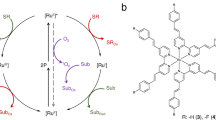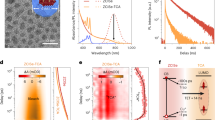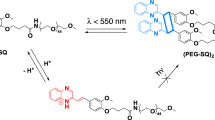Abstract
Recent advances in photoredox catalysis have made it possible to achieve various challenging synthetic transformations, polymerizations and surface modifications1,2,3. All of these reactions require ultraviolet- or visible-light stimuli; however, the use of visible-light irradiation has intrinsic challenges. For example, the penetration of visible light through most reaction media is very low, leading to problems in large-scale reactions. Moreover, reactants can compete with photocatalysts for the absorption of incident light, limiting the scope of the reactions. These problems can be overcome by the use of near-infrared light, which has a much higher penetration depth through various media, notably biological tissue4. Here we demonstrate various photoredox transformations under infrared radiation by utilizing the photophysical process of triplet fusion upconversion, a mechanism by which two low-energy photons are converted into a higher-energy photon. We show that this is a general strategy applicable to a wide range of photoredox reactions. We tune the upconversion components to adjust the output light, accessing both orange light and blue light from low-energy infrared light, by pairwise manipulation of the sensitizer and annihilator. We further demonstrate that the annihilator itself can be used as a photocatalyst, thus simplifying the reaction. This approach enables catalysis of high-energy transformations through several opaque barriers using low-energy infrared light.
This is a preview of subscription content, access via your institution
Access options
Access Nature and 54 other Nature Portfolio journals
Get Nature+, our best-value online-access subscription
$29.99 / 30 days
cancel any time
Subscribe to this journal
Receive 51 print issues and online access
$199.00 per year
only $3.90 per issue
Buy this article
- Purchase on Springer Link
- Instant access to full article PDF
Prices may be subject to local taxes which are calculated during checkout




Similar content being viewed by others
Data availability
The data that support the findings of this study are available from the corresponding authors on reasonable request.
Change history
15 May 2019
In Fig. 1c of this Letter, the orange axis label of the graph should have read ‘FDPP upconversion photoluminescence (AU)’ instead of ‘TTBP upconversion photoluminescence (AU)’. This has been corrected online.
References
Prier, C. K., Rankic, D. A. & MacMillan, D. W. C. Visible light photoredox catalysis with transition metal complexes: applications in organic synthesis. Chem. Rev. 113, 5322–5363 (2013).
Romero, N. A. & Nicewicz, D. A. Organic photoredox catalysis. Chem. Rev. 116, 10075–10166 (2016).
Cambié, D., Bottecchia, C., Straathof, N. J. W., Hessel, V. & Noël, T. Applications of continuous-flow photochemistry in organic synthesis, material science, and water treatment. Chem. Rev. 116, 10276–10341 (2016).
Smith, A. M., Mancini, M. C. & Nie, S. Bioimaging: second window for in vivo imaging. Nat. Nanotechnol. 4, 710–711 (2009).
Arias-Rotondo, D. M. & McCusker, J. K. The photophysics of photoredox catalysis: a roadmap for catalyst design. Chem. Soc. Rev. 45, 5803–5820 (2016).
Le, C. C. et al. A general small-scale reactor to enable standardization and acceleration of photocatalytic reactions. ACS Cent. Sci. 3, 647–653 (2017).
Zhou, J., Liu, Q., Feng, W., Sun, Y. & Li, F. Upconversion luminescent materials: advances and applications. Chem. Rev. 115, 395–465 (2015).
Schulze, T. F. & Schmidt, T. W. Photochemical upconversion: present status and prospects for its application to solar energy conversion. Energy Environ. Sci. 8, 103–125 (2015).
Park, Y. I., Lee, K. T., Suh, Y. D. & Hyeon, T. Upconverting nanoparticles: a versatile platform for wide-field two-photon microscopy and multi-modal in vivo imaging. Chem. Soc. Rev. 44, 1302–1317 (2015).
Zhou, Y. et al. An upconverted photonic nonvolatile memory. Nat. Commun. 5, 4720 (2014).
Viger, M. L., Grossman, M., Fomina, N. & Almutairi, A. Low power upconverted near-IR light for efficient polymeric nanoparticle degradation and cargo release. Adv. Mater. 25, 3733–3738 (2013).
He, S. et al. Ultralow-intensity near-infrared light induces drug delivery by upconverting nanoparticles. Chem. Commun. 51, 431–434 (2015).
Chen, Z., Sun, W., Butt, H.-J. & Wu, S. Upconverting-nanoparticle-assisted photochemistry induced by low-intensity near-infrared light: how low can we go? Chem. Eur. J. 21, 9165–9170 (2015).
Askes, S. H. C., Bahreman, A. & Bonnet, S. Activation of a photodissociative ruthenium complex by triplet–triplet annihilation upconversion in liposomes. Angew. Chem. Int. Ed. 53, 1029–1033 (2014).
Mahboub, M., Huang, Z. & Tang, M. L. Efficient infrared-to-visible upconversion with subsolar irradiance. Nano Lett. 16, 7169–7175 (2016).
Majek, M., Faltermeier, U., Dick, B., Pérez-Ruiz, R. & Jacobi von Wangelin, A. Application of visible-to-UV photon upconversion to photoredox catalysis: the activation of aryl bromides. Chem. Eur. J. 21, 15496–15501 (2015).
Häring, M., Pérez-Ruiz, R., Jacobi von Wangelin, A. & Díaz, D. D. Intragel photoreduction of aryl halides by green-to-blue upconversion under aerobic conditions. Chem. Commun. 51, 16848–16851 (2015).
Singh-Rachford, T. N. & Castellano, F. N. Low power visible-to-UV upconversion. J. Phys. Chem. A 113, 5912–5917 (2009).
Singh-Rachford, T. N. & Castellano, F. N. Photon upconversion based on sensitized triplet–triplet annihilation. Coord. Chem. Rev. 254, 2560–2573 (2010).
Hartnett, P. E. et al. Effects of crystal morphology on singlet exciton fission in diketopyrrolopyrrole thin films. J. Phys. Chem. B 120, 1357–1366 (2016).
Singh-Rachford, T. N. & Castellano, F. N. Pd(II) phthalocyanine-sensitized triplet–triplet annihilation from rubrene. J. Phys. Chem. A 112, 3550–3556 (2008).
Neumann, M., Füldner, S., König, B. & Zeitler, K. Metal-free, cooperative asymmetric organophotoredox catalysis with visible light. Angew. Chem. Int. Ed. 50, 951–954 (2011).
Mashraqui, S. H. & Kellogg, R. M. 3-Methyl-2,3-dihydrobenzothiazoles as reducing agent. Dye enhanced photoreactions. Tetrahedr. Lett. 26, 1453–1456 (1985).
Natarajan, P., Kumar, N. & Sharma, M. Visible light-mediated intramolecular C–H arylation of diazonium salts of N-(2-aminoaryl)benzoimines: a facile synthesis of 6-arylphenanthridines. Org. Chem. Front. 3, 1265–1270 (2016).
Sommer, J. R. et al. Photophysical properties of near-infrared phosphorescent π-extended platinum porphyrins. Chem. Mater. 23, 5296–5304 (2011).
Deng, F., Sommer, J. R., Myahkostupov, M., Schanze, K. S. & Castellano, F. N. Near-IR phosphorescent metalloporphyrin as a photochemical upconversion sensitizer. Chem. Commun. 49, 7406–7408 (2013).
Sasaki, Y., Amemori, S., Kouno, H., Yanai, N. & Kimizuka, N. Near infrared-to-blue photon upconversion by exploiting direct S–T absorption of a molecular sensitizer. J. Mater. Chem. C 5, 5063–5067 (2017).
Ischay, M. A., Anzovino, M. E., Du, J. & Yoon, T. P. Efficient visible light photocatalysis of [2+2] enone cycloadditions. J. Am. Chem. Soc. 130, 12886–12887 (2008).
Miyake, G. M. & Theriot, J. C. Perylene as an organic photocatalyst for the radical polymerization of functionalized vinyl monomers through oxidative quenching with alkyl bromides and visible light. Macromolecules 47, 8255–8261 (2014).
Tucker, J. W., Zhang, Y., Jamison, T. F. & Stephenson, C. R. J. Visible-light photoredox catalysis in flow. Angew. Chem. Int. Ed. 51, 4144–4147 (2012).
Acknowledgements
L.M.C. thanks the National Science Foundation (NSF CAREER DMR-1351293) for funding. A.B.P. thanks the NSF Graduate Research Fellowship Program (DGE-16-44869). D.N.C. is supported by the Rowland Fellowship at the Rowland Institute at Harvard. T.R. thanks the National Institute of General Medical Sciences (GM125206).
Author information
Authors and Affiliations
Contributions
A.B.P. and D.N.C. carried out the upconversion experiments. B.D.R., A.B.P. and E.M.C. performed and analysed the photoredox and materials penetration experiments. D.N.C., T.R. and L.M.C. initiated and directed the study, and wrote the manuscript with contributions from all authors.
Corresponding authors
Ethics declarations
Competing interests
A provisional patent has been filed on this technology by the institutions on behalf of the authors of this work (US Provisional Application 62/641,739).
Additional information
Publisher’s note: Springer Nature remains neutral with regard to jurisdictional claims in published maps and institutional affiliations.
Supplementary information
Supplementary Information
This file contains supplementary text, which includes supplementary figures S1-S10 and supplementary table S1.
Rights and permissions
About this article
Cite this article
Ravetz, B.D., Pun, A.B., Churchill, E.M. et al. Photoredox catalysis using infrared light via triplet fusion upconversion. Nature 565, 343–346 (2019). https://doi.org/10.1038/s41586-018-0835-2
Received:
Accepted:
Published:
Issue Date:
DOI: https://doi.org/10.1038/s41586-018-0835-2
This article is cited by
-
X-ray-activated polymerization expanding the frontiers of deep-tissue hydrogel formation
Nature Communications (2024)
-
Triplet–triplet annihilation photon upconversion-mediated photochemical reactions
Nature Reviews Chemistry (2024)
-
Molecular near-infrared triplet-triplet annihilation upconversion with eigen oxygen immunity
Nature Communications (2024)
-
Promoting multiexciton interactions in singlet fission and triplet fusion upconversion dendrimers
Nature Communications (2023)
-
Red light-driven electron sacrificial agents-free photoreduction of inert aryl halides via triplet-triplet annihilation
Nature Communications (2023)
Comments
By submitting a comment you agree to abide by our Terms and Community Guidelines. If you find something abusive or that does not comply with our terms or guidelines please flag it as inappropriate.



